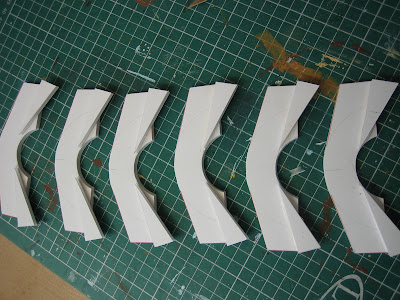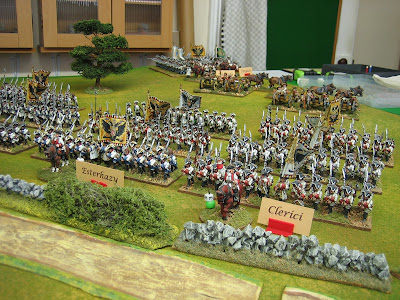Having made about seventeen feet of stream some time ago I needed some bridges. I decided on three. They needed to be small, so simple humpbacked bridges seemed the best route. I chose to go simple. I chose to go cheap. I chose to play a trick. Then I built them, fell ill and didn't post this as originally intended - fortunately I remembered to take the memory card out of my camera so that I didn't accidentally erase the pictures; erasing pictures on the camera card is something I do regularly to speed up the find and download process.
You don't need many materials or tools to make these things, and those materials you will need are useful for many other things - so no pointlessly wasted materials left over. Cheap as chips - £0.50 each, tops.
Biggest cost can be seen here, 5mm foam board. But, it has so many uses that you'll use what you don't use on this job for others - zero waste here.
Having marked out the sides of the bridge using a set square, ruler and a compass onto 5mm foam board I cut the shapes out using a surgical scalpel with a 10A blade.
Note that the bridge was deeper than this when it was drawn: It's had about 5mm cut off the bottom; that's where the compass point at the centre of the circles was located. The arch isn't quite a whole semicircle.
My stubby handled size 10 scalpel is probably the most used tool I own - I use it for just about everything because the blades are much cheaper than craft blades, and if you mutter to yourself whilst you work, it's funny to say "Scalpel, nurse." once in a while.
If you are watching carefully you will have noticed the trick I'm about to pull already. Can you see it yet?
Edit for RichardL: Easier said than done now they are made but, approx dimensions are: Length 120mm. Height 40mm. The lower arch at waterline is 40mm across. The arch corresponds to the width of my stream and it is that wide for no other reason. Just do what feels right for the water you want to cross. If the river is much wider you may need two or more arches like this one I made some time ago.
I didn't throw away the angles from the top of the bridge walls as these will be used....
...to make the ramps that will support the roadway.
The trick is obvious now, isn't it?
Whilst the roadway support ramps were drying, I cut out my 2mm MDF bases to match my stream basing.
This is another outlay similar to the foam board but, again MDF is such a useful thing to have around the place.
BTW: To buy quite small pieces of 2mm MDF look up picture framing supplies - it's used for backing pictures.
I cut the excess off from the road ramps and now the basic structural work is done.
Got the conceit I'm planning. Surely you see the trick now?
I added my stream texture, and two strips of foam board to the basing. These foam board pieces will stiffen the bottom of the lower arch and keep its sides straight at water level. (See second picture down: That picture shows how these strips work).
You can see that I do my footprint plans bold, using a fine felt tipped pen. The "52mm" is to remind me how wide to cut my roadway.
Also note that before I did the water texture I masked off the areas where the bridge will sit. This needs to be flat.
The lower arches, made from thin card. I actually used cartridge paper in this case but, anything from old Christmas cards to cornflake packet is about right.
The pins just hold everything in place whilst the glue dries.
Now here is the big fudge: The conceit that makes these bridges work.
The problem with wargame bridges is that they usually have to go over water that is above ground level. Obviously, 'in the wild' streams flow a few feet below the level of the surrounding ground. This means that the arches of a wargame bridge, to look right as arches, actually have to be higher above ground level than they should be. This causes a problem for the modeller. Either he has to have bridges with an incredibly steep roadway or he has to make bridges overly long to make the road gradient less steep.
I have done neither. My conceit is to lay the roadway directly over the lower arch, thus reducing the overall height of the roadway by 6mm - 7mm. Thus, the bridge can be short and the road gradient shallow. But, the level of the road is lower than the stone arch on the outer wall of the bridge that is supposed to support it. That's the trick! The eye will be tricked by not being able to see both the outer arch and the roadway at the same time. It's so simple, it's downright stupid.
Because I was using cartridge paper I did my roadway three layers thick, one applied after the other. If I had used Christmas cards, two layers would have sufficed. The last layer went over the base edge and was trimmed flush when dry - only do this with the last layer; cut the other layers shorter, as in the picture above.
After doing the brickwork using thin balsa wood (bricks and arch-work) or mounting card (top stones on the walls), and texturing it and painting it with household acrylics (Dulux emulsion paint), I coated the roadway with a strong mix of plaster filler and PVA / water (1:1).
I painted the road, adding a few rocks and some 'verge' to the inner surfaces, and based and painted the stream to blend into my streams.
Here the conceit of the roadway is explained. The eye doesn't see the relative heights of the arch and the road because it can't see where they join. It is tricked completely.
One last point. Most humpbacked bridges have a splayed entrance, the roadway being wider at the entrance to the bridge and narrower in the middle. This is actually very difficult to do and causes problems when it comes to cutting the shape of the roadway. To make things simple for myself, I chose to ignore this facet of a humpbacked bridge completely: K.I.S.S.























